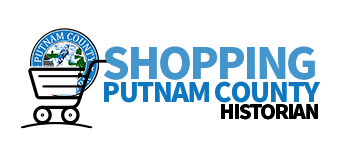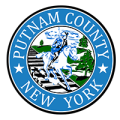
Historian
Mission Statement
Welcome to the Putnam County Historian’s Office and Archives! We are located in Brewster, New York, in the lower Hudson River Valley region.
Our local government office preserves, interprets, and promotes the history of Putnam County. New York’s Town and Village Historians have been serving public history since 1919, in part to document World War I Veterans back into civilian life.
Contact the
Putnam County Historian
-
Office | 845.808.1420
-
Fax | 845.278.4865
-
Email | Send us a message
-
Address | 68 Marvin Ave. Brewster, NY 10509
County Historian
Services Offered
See how Putnam County's boundaries changed starting from 1683 to present day!
Putnam County Historians have been collecting primary material since the 1950s to preserve Putnam’s past for future generations. The papers in the Collection have been arranged and described. The Historian’s Office welcomes the donation of private papers, maps, and photographs that shed light on the County’s past, as well as the gift of collections relating to contemporary subjects to be preserved for future generations.
Display panels relating to Putnam County’s history have been developed by the Putnam County Historian’s Office since 1991. They may be borrowed by schools, historical societies, museums, and civic groups. Each panel is 40″ X 30″ and mounted vertically. They are framed and under Plexiglas. Most have wires for hanging them (or you may attach wires) or they may be propped against a wall or a chalkboard. It is sometimes possible to borrow the bases on which you may mount four panels at a time, “kiosk” style. The exhibits may be inspected at the Historian’s Office to see if they suit your purposes. Please call ahead if you want to see them.
A program to research, recognize, and mark old houses & structures in Putnam County is Sponsored by The Office of the Putnam County Historian & The Putnam County Historic Preservation Advisory Commission
Purpose of Program
Many of us, especially those who have moved toPutnamCountyfrom somewhere else, drive past old houses and wonder how old they are or who lived there before our day. In other communities, we often see signs on houses that mark the names of the first owners or the approximate date of constructio
Putnam’s Origins, 1691-1776
When the Half Moon anchored in the Hudson in 1609, the area on the east bank was inhabited by a band of Native Americans called the Wappingers, sometimes known as the “River Indians”. This group of Munsee-speaking Delawares farmed in the valleys, hunted in the forests and swamps, and gathered shellfish in the Hudson estuary in the land that would become Putnam County. No European settlements are known to have occurred here during the 17th century, but the Wappingers had regular contact with Dutch traders from whom they acquired trade goods in return for beaver pelts. They also acquired disease, alcohol, and firearms, decimating their people.
Archival and documentary sources in the county are often to be found in its towns and villages. Vital records (births, marriages and deaths) have been kept in the offices of the town and village clerks who are the records management officers (RMOs) of their municipalities.
Each local government has a local government historian who may be contacted if you have questions about his or her town or village.
If you are interested in a particular town or village, click on the municipality to learn about the RMOs, the municipal historians, the local historical societies and museums, and the local libraries.
News
Remembering the Service and Sacrifice of Kent’s Corporal Kenneth “Kenny” Townsend
-
 Putnam County Takes Flight: National Air Mail Week, 1938
Putnam County Takes Flight: National Air Mail Week, 1938 -
 The three libraries along the historic route Sybil Ludington rode on the night of April 26 1777
The three libraries along the historic route Sybil Ludington rode on the night of April 26 1777 -
 Town of Carmel - Red Mills Historic Markers Refurbished
Town of Carmel - Red Mills Historic Markers Refurbished -
 Willitt C. Jewell’s Putnam County” Republished by County Historian’s Office 10-22-2024
Willitt C. Jewell’s Putnam County” Republished by County Historian’s Office 10-22-2024 -
 Remembering Dorothy Jewell A Woman of Cause and Community - Historian
Remembering Dorothy Jewell A Woman of Cause and Community - Historian -
 Remembering Mother Ruth: A trailblazer who created a Community on a historic Putnam County homestead
Remembering Mother Ruth: A trailblazer who created a Community on a historic Putnam County homestead -
 Remembering Ruth McGinnis, the “Queen of Billiards”
Remembering Ruth McGinnis, the “Queen of Billiards” -
 A Tribute To Life On The Lake
A Tribute To Life On The Lake -
 Remembering Angela Lansbury – Star of stage and screen who sought refuge from the Nazis, came to Putnam County
Remembering Angela Lansbury – Star of stage and screen who sought refuge from the Nazis, came to Putnam County -
 Willitt C. Jewell's Putnam County : A Pop-Up Historic Photo Gallery at Spain Cornerstone
Willitt C. Jewell's Putnam County : A Pop-Up Historic Photo Gallery at Spain Cornerstone -
 The Putnam County Clerk’s Office: A Bicentennial
The Putnam County Clerk’s Office: A Bicentennial -
 Women's History - Remembering Putnam County Artist In Residence Frances O'Brien
Women's History - Remembering Putnam County Artist In Residence Frances O'Brien -
 Sybil Ludington in Smithsonian Magazine
Sybil Ludington in Smithsonian Magazine -
 Remembering Louis B. Garrison
Remembering Louis B. Garrison -
 Local Historians Pen Valuable Putnam County History In Putnam Valley: A Look Back
Local Historians Pen Valuable Putnam County History In Putnam Valley: A Look Back -
 PUTNAM COUNTY MARKS HISTORY
PUTNAM COUNTY MARKS HISTORY -
 Putnam County Day 2021 Another Virtual Celebration, June 12, 2021
Putnam County Day 2021 Another Virtual Celebration, June 12, 2021 -
 Remembering Regina Anderson Andrews
Remembering Regina Anderson Andrews -
 Putnam in the Pandemic Recording COVID-19 Stories
Putnam in the Pandemic Recording COVID-19 Stories -
 Remembering Gil “Crying Hawk” Tarbox
Remembering Gil “Crying Hawk” Tarbox -
 Remembering Putnam’s Past: Sumner H. Lark, one of the first African Americans appointed Assistant D.A. in NY
Remembering Putnam’s Past: Sumner H. Lark, one of the first African Americans appointed Assistant D.A. in NY -
 WWI’s Sgt. Clinton Peterson, Pride of Putnam
WWI’s Sgt. Clinton Peterson, Pride of Putnam -
 Remembering Fanny Crosby
Remembering Fanny Crosby -
 For the Holidays, Limited Edition Local History Gifts
For the Holidays, Limited Edition Local History Gifts -
 Historic Treasures: The Pandemic’s Silver Lining
Historic Treasures: The Pandemic’s Silver Lining -
 Historic Putnam County & the Birth of the American Circus
Historic Putnam County & the Birth of the American Circus -
 Honoring Putnam County Veterans
Honoring Putnam County Veterans -
 Archives Edition – Series 100: A Stallion’s Family Tree
Archives Edition – Series 100: A Stallion’s Family Tree -
 Remembering Marjorie Addis, Suffragist to Editor-in-Chief, and everything in between
Remembering Marjorie Addis, Suffragist to Editor-in-Chief, and everything in between
About
Staff
Historian: Jennifer Cassidy
Deputy Historian: Sallie Sypher*
The County Historian’s Office and the Archives are staffed by part-time personnel and volunteers:
Research/clerical assistants:
LaReva Greene
Dana Veitinger
Volunteers:
Juliet Aguiar
Elizabeth Allison*
Michele Calson
We welcome volunteers to work with the archives, the library, the maps and photographs and to assist in research. Call the office if you are interested.
Hours & facilities
The Historian’s Office is open to the public for research Monday through Wednesday, 10 am – 2 pm, by appointment only and except legal holidays. Call or email for appointments or details.
The public is invited to use the Archives, Library, and Collection, weekdays by pre-arrangement. Those wishing to do research are asked always to notify the County Historian’s Office in advance of their visit.
Facilities Available:
There is no charge for using the Library, Collection and County Archives. Parking is free.
A computer is available for public use for searching the databases and for note taking. There is no charge. Researchers may photograph records without charge.
Fees are charged for photocopying, ranging from 20¢ to 40¢ per page, depending on paper size.
There is a $5.00 charge for scanning photos. The charge for multiple scans will depend on how complicated the project is and how much staff time is required.
There is a microfilm-reader printer. Photocopies of microfilm are 40¢ each.
The Office, Library and restroom are accessible to the disabled.
Travel Directions
-
From West & South via Taconic & US 6
Exit Taconic on US 6 going right (east). US 6 east into Brewster. Where US 6 bears left at RR station, go straight. Take first left (Marvin Avenue) to Records Center.
-
From North by Taconic/I-84
Take I-84 east to exit 20N; then take immediate exit 10; then US 202 & 6 to Brewster. Right on US 6 over bridge at a traffic light and next left (Marvin Ave.) to Records Center on right.
-
From South by Saw Mill & I-684
Saw Mill will merge with I-684. Continue on I-684 to Exit 8 (Hardscrabble Rd.). Go left and straight when Route NY 22 enters from the left. Continue on 22 north through Croton Falls (US 202 east will join NY 22). Take first left after reservoir (sign says to US 6 west) and second right (Marvin Avenue) to Records Center on left.
-
From West & North By NY 301
US 301 to Carmel & right on NY 52 at Courthouse. Left on US 6 East in front of Reed Library. Follow US 6 into Brewster. Where 6 bears left at RR station, go straight. Take first left (Marvin Avenue) to Records Center on left.
-
From East by I-84 or US 6
I-84 to Rte. 121 exit (US 6 & US 202 west). Right on 121 and left on US 202 & 6 to a traffic light where US 6 goes right. Go right over bridge at light & take first left (Marvin Ave.) to Records Center on right.
-
By Train
The Historian’s Office can also be reached by train. We are within walking distance from the Brewster station on the Harlem Line out of Grand Central Station. There are taxis at the train station in Brewster.
Boundary Changes
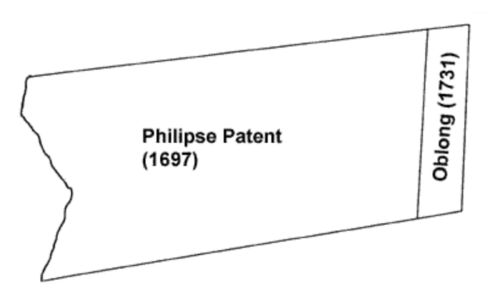
Over the years, the boundaries and names of Putnam County and of its political subdivisions changed frequently.
1683 Civil Divisions of Dutchess County formed by Colonial Legislature
1697 Philipse Patent granted to Adolph Philipse
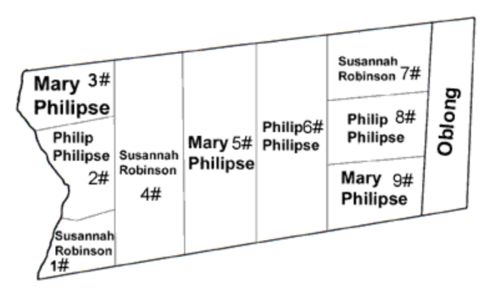
1719 Dutchess County divided into 3 “divisions” called “wards”
1731 Thomas Hawley and others receive patent for The Oblong
1737 Area styled “South Precinct” by Colonial Assembly
1754 Patent divided into 9 lots after death of Adolph Philipse
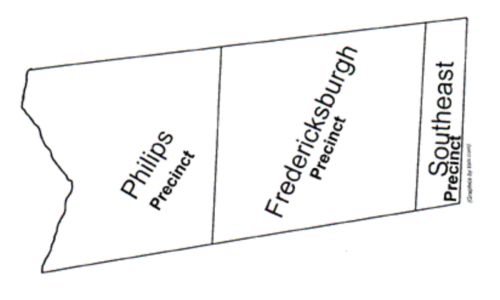
1772 Precinct divided into Southeast, Philips, and Fredericksburgh Precincts
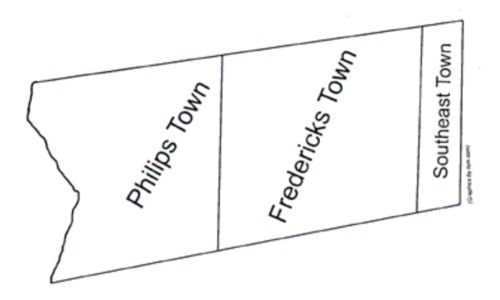
1778 Precincts become towns
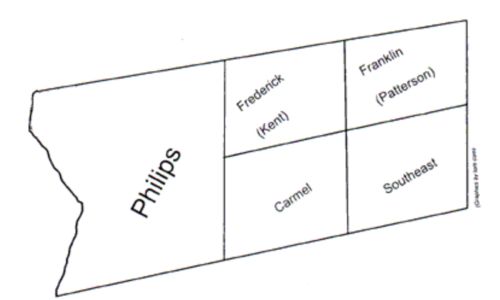
1795 Act to divide Frederickstown and Southeast Town into towns of Carmel, Frederick, Franklin, and Southeast
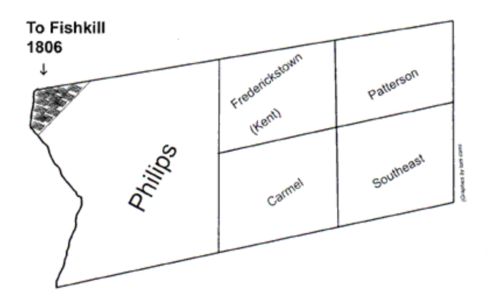
1806 Fishkill annexes northwest corner of Philipstown
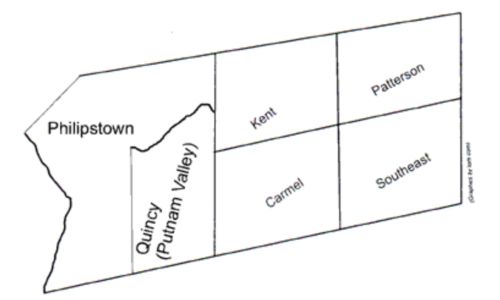
1808 Name of Franklin changed to Patterson
1812 Act to divide Dutchess County, creating Putnam County
1817 Name of Frederick changed to Kent
1839 Philipstown divided, and Town of Quincy created
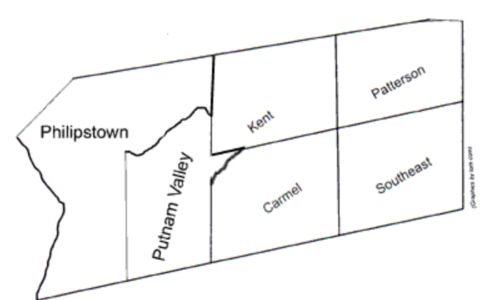
1840 Name of Quincy changed to Putnam Valley
1861 Part of Carmel west of Peekskill Hollow Creek annexed by Putnam Valley
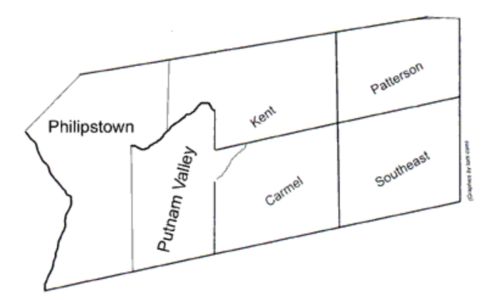
1879 Northwestern Philipstown ceded to Kent
Historians Collection
Historical Records
Putnam County Historians have been collecting primary material since the 1950s to preserve Putnam’s past for future generations. The papers in the Collection have been arranged and described. The Historian’s Office welcomes the donation of private papers, maps, and photographs that shed light on the County’s past, as well as the gift of collections relating to contemporary subjects to be preserved for future generations.
The Historic Document Collection encompasses a variety of subjects including iron mining, smelting and forging, Drew Seminary, cattle drovers, menageries and the early circus, civic and fraternal organizations, county politics, local businesses, and family history.
Map Collections
There is an indexed map collection containing original and copied maps dating from the late 18th century to the present day. The map collection is especially useful for anyone engaged in research in –
- county history
- family and house histories
- environmental assessments
- railroad and transportation history
- iron mining history
Three 19th century maps are particularly useful because they show property owners and because there are some detailed insets of villages and hamlets. Paper copies of the Beers 1867 town maps are available for sale. There are scans in sections of the1854 O’Connor map and the 1876 Reed map and of the individual towns and villages in the 1867 Beers map.
Oral History Videos
Photographs
There is a fully indexed collection of photographs, slides, and postcards that document the County’s past and present.
Of particular interest are –
- Photographs taken by Willitt C. Jewell, editor of The Putnam County Courier from the 1920s through the 1960s
- Photographs taken by staff photographers of the weekly Patent Trader dating from the 1950s to 1980s.
- Photos taken by Allison Albee in the 1930s.
- Detailed aerial photographs of the county taken for county planners in 1933, 1963, and 1986.
- A large collection of postcards, mostly from the first years of the 20th century, donated by Mr. and Mrs. David Tischler.
The Office has the capability of scanning and printing high quality reproductions of the photographs, which may be published with permission or scanned and e-mailed to researchers for a fee.
Pamphlets & Booklets
The County Historian has an indexed collection of pamphlets, annuals, commemorative journals and booklets published for –
- Organizations
- political parties
- businesses
- churches
- veterans’ organizations
- tourism
- volunteer services
- newcomers
- chambers of commerce
- anniversaries
Historical Displays
Display panels relating to Putnam County’s history have been developed by the Putnam County Historian’s Office since 1991. They may be borrowed by schools, historical societies, museums, and civic groups. Each panel is 40″ X 30″ and mounted vertically. They are framed and under Plexiglas. Most have wires for hanging them (or you may attach wires) or they may be propped against a wall or a chalkboard. The exhibits may be inspected at the Historian’s Office to see if they suit your purposes. Please call ahead if you want to see them.
There is no charge for borrowing the panels. The borrower is responsible for transporting the panels to the exhibit site and for returning them to the Historian’s Office in good condition by the promised return date. Persons wishing to borrow the panels should schedule their use with the County Historian’s Office at (845) 808-1420 or at
Subjects of Displays
-
Rivers, Roads and Rails: Movin’ Through Putnam
-
Cars in the County
-
Cabins to Castles
-
Putnam Preserves its Past
-
The Restoration of the Courthouse
-
Nimham and the Native Americans
-
The Control of the Highlands
-
Putnam County during the Civil War
-
Seeking a Better Life
-
Putnam County in the World Wars
-
The Putnam County Origins of the American Circus
-
The Mills of Putnam County
-
The New York City Reservoirs in Putnam County
-
What Killed the “Old Put”?
-
Rivers, Roads and Rails: Movin’ Through Putnam
The exhibit deals with early transportation in Putnam County: Hudson River commerce, the coming of the railroads, and the old roads and turnpikes. (16 panels)
-
Cars in the County
A sequel to “Rivers, Roads and Rails”, this exhibit shows the impact of the automobile on the suburbanization of Putnam County. (11 panels)
-
Cabins to Castles
The exhibit shows the changes in Putnam County architecture from the days of the log cabin to the present. (14 panels)
-
Putnam Preserves its Past
The exhibit examines the state of historic preservation in Putnam County, successes as well as failures. (8 panels)
-
The Restoration of the Courthouse
This small exhibit was created for the reopening of the newly-restored historic courthouse in 1996. (4 panels)
-
Nimham and the Native Americans
This exhibit tells the story of the first people in Putnam County, the development of Lenape culture, and the story of the Wappingers and their unhappy fate. (8 panels) Traveling cases displaying a collection of local Native American artifacts have been deposited by the Putnam County Historical Society and Foundry School Museum and may be loaned in conjunction with the panels.
-
The Control of the Highlands
Putnam County in the American Revolution. The exhibit focuses on the pivotal importance of the Hudson Highlands in the winning of the War of Independence and on the career of Gen. Israel Putnam, for whom the County is named. (8 panels)
-
Putnam County during the Civil War
The exhibit tells of the County’s role in the Civil War, especially as the war affected the people and industries at home. (8 panels)
-
Seeking a Better Life
Three Centuries of Ethnic Change in Putnam County. The exhibit traces the changing population groups in Putnam County. (8 panels) An additional panel is available depicting recent Central American immigrants.
-
Putnam County in the World Wars
The exhibit tells the story of the Putnam County homefront during World War I and World War II. (8 panels)
-
The Putnam County Origins of the American Circus
Wild animal menageries, equestrian shows and acrobatic displays preceded the circus that we know today. Men from eastern Putnam and northern Westchester pioneered in these enterprises. Seth B. Howes of Brewster was the greatest showman of his day. (4 panels)
-
The Mills of Putnam County
Panels depicting the various kinds of mills in each of Putnam County’s six towns (two panels for the Town of Carmel) (7 panels)
-
The New York City Reservoirs in Putnam County
Panels depicting construction of the reservoirs, contamination problems, security issues, and the relocation and displacement of structures and cemeteries, and a watershed map with descriptions of each reservoir. (5 panels)
-
What Killed the “Old Put”?
The story of the tribulations and decline of the railroad that brought rail travel to the interior of Putnam County. (2 panels)
Library
Books and Reference
The County Historian maintains a reference library of state, regional, local and family history, consisting of histories and biographies, reference works, and printed collections of historical documents. The library materials are for reference only and may not be loaned.
Of special interest are –
- Histories of Putnam County and its towns
- Published town, church & cemetery records
- Printed guides to other archives
- Bibliographies
- Biographies of Putnam County people
- Gazetteers from 1814
- State census statistics 1835-1885
- Books and articles about Native Americans
- Federal census schedules, many indexed
- Records of Board of Supervisors
- Records of Putnam County Legislature
- History encyclopedias
Genealogy and Family History
The Library is rich in family history resources. Beside the vertical family files, there is a great variety of primary and secondary material useful for searching one’s family’s past. Some of the more important sources and guides follow:
- Censuses. We hold on microfilm all of the Federal censuses schedules for Putnam County from 1790 to 1930. Indexed paper copies of many censuses prepared by Glendon E. Wheeler are also available. The 1915 and 1925 NYS censuses for the county and the 1845 state census for Kent and Philipstown are here as well.
- Records in the County Archives such as probate records, deeds, and court records. (see County Archives for more relevant series)
- There is a master database of more than 125,000 entries that point to names found in records held in the Archives (deeds, wills, court cases, etc.) and in the non-governmental records in the Historian’s Collection.
- Lineage Books 2-166 of the Daughters of the American Revolution have been deposited here by the DAR for public use.
- Cemetery records for Putnam County and adjoining towns
- Published and unpublished church records
- Information on individual families’ histories found in the vertical files and in published and unpublished genealogies
Newspapers and Periodicals
Newspapers
The Library holds the following newspapers (M=microfilm):
- The Cold Spring Recorder, 1867-1935 (M)
- The Community Current, 1984-1990 (gaps)
- The Patterson Weekly News, 1901-1918 (M) & bound copies
- The Putnam County Courier, 1851-1972 (gaps)
- The Putnam County Democrat, 1849-1851
- The Putnam County News and Recorder, 1950-1999 (M)
- The Putnam County Republican, 1882-1946 (many gaps)(M)
- The “morgue” of articles relating to Putnam County from The Patent Trader (partially indexed) 1956-1988
Periodicals:
The County Historian’s Office subscribes to
- CRM and Common Ground
- Heritage
- Historic Preservation
- New York Archives
- New York History
- The Hudson River Valley Review (formerly the Hudson Valley Regional Review)
- The New-York Journal of American History
In addition, it maintains some past runs (incomplete) of
- The Dutchess County Yearbooks
- The Nimham Times
- The NY Genealogical and Biographical Record
- The Westchester Historian
Vertical Files
The Library has vertical files on a variety of subjects. They consist primarily of newspaper clippings, dating from the mid 19th century to the present. Some of the most important categories are:
- Genealogy files – individual family histories, most submitted by various genealogical researchers and some developed by Archives staff
- Sites & structures – information on buildings and places of historic interest in the county Churches & places of worship, including some church records
- Issues in county, town, and village government
- Planning, zoning and environmental issues
- Open space preservation
- People important in Putnam’s past, e.g. Sybil Ludington, Enoch Crosby, James Kent, et al.
- Schools – rural schools in history and today’s central school districts
- Local business and trades
- Farming
- Iron mining, smelting, and casting
- New York City reservoirs
Old House Program
-
Marking Your Old House
A program to research, recognize, and mark old houses & structures in Putnam County is Sponsored by The Office of the Putnam County Historian & The Putnam County Historic Preservation Advisory Commission
Purpose of Program
Many of us, especially those who have moved toPutnamCountyfrom somewhere else, drive past old houses and wonder how old they are or who lived there before our day. In other communities, we often see signs on houses that mark the names of the first owners or the approximate date of construction.
-
Who May Apply?
The owner(s) of any house that
- appears on the 1854 O’Connor map, the 1867 F.W. Beers map or the 1876 Thomas Reed map
- any house that is of architectural importance, even if it is of recent construction
- any house in which a notable person lived or in which an significant event took place (The importance of the house or event may be regional.)
Why Should I Apply?
Anyone who has lived in an old house knows that it is both a challenge and a joy to care for it. It is a challenge because the repairs, maintenance, and upkeep of an old house are much more expensive the care of a new one! But the joy comes from being a steward of a house that generations before you have lived in and that generations after you will enjoy as well. Yours is not a “tear down” but a treasure. Marking it will show you care and will educate others to care as well.
-
How Do I Find Out About My House?
Assuming that you wish to apply for a plaque because your house is old, you may click on “Some Tips on Tracing the History of Your Old House.” Your local historical society, your town or village historian, and the Putnam County Historian’s Office andCountyArchivescan help.
Why Should I Bother?
A house is more than wood and shingles! It’s also the story of the people who lived there; and much of the enjoyment of living in an old house comes from imagining the lives of your predecessors. You may find that town meetings were held in your house, that a “pound master” lived there, that one woman raised seventeen children in your house, or even that a prior owner was convicted of arson!
-
How Do I Apply?
There is a simple form to be completed (click on “application form” & print it), and we ask for up-to-date photographs of the exterior of the house. If there are any interesting architectural details inside, it’s good to include interior photographs as well. Some of the work may already have been done for you as many houses in Putnam County have already been described by an architectural historian or have been the subject of a historic structure report) or have already been declared eligible to apply for the National Register. In those cases, your job is really easy. You may then submit your form and photographs to a committee that will consult with your town or village historian or historical society. If your house is approved, you may purchase the brass plaque to affix to your house or to a sign. Documentation, including the photographs, of your house will be preserved in the Putnam County Archives for students and future owners to consult and for future generations inPutnamCounty.
-
How Will My House Be Marked?
If your house enters the program, you may purchase (for TBD) a brass marker showing the ox, rake & plow of the first official seal ofPutnamCountyshown above. You may affix it to your house, or you may choose to place it on a historical marker showing the name(s) of early owners and/or the date of construction. Nothing in this program prevents you from making alterations or additions to your house, painting it to your liking, or limiting your use in any way. It does show that you care about the legacy of past generations and the preservation of your house’s story for those who come after us.
Such signs attest to owners’ interest in their properties and a community’s pride in its history. Putnam County’s program is designed to recognize old houses that may or may not be eligible to be listed on the National and State Registers of Historic Places.
The “Marking Your Old House” Program is created so that homeowners may learn about their old house, have its history attested to by designated historians, and have a plaque that will be uniform throughout the county placed on their house or a sign in front of their house.
-
Learn More About This Program
Call the Putnam County Historian’s Office for more information.
We can be reached at:Telephone: (845) 278-7209
e-mail:This email address is being protected from spambots. You need JavaScript enabled to view it.
Fax: (845) 278-4865
By Mail: Putnam County Historian’s Office
68 Marvin Avenue, Brewster NY 10509
Putnam in the Pandemic

The Putnam County Historian’s Office is seeking the public’s help to chronicle “Putnam in the Pandemic”, stories and images that document the extraordinary conditions we have lived through during COVID-19. Please use this form to contribute your story.
For those unable to submit online, oral history recordings may be arranged by contacting the Historian’s Office. For further information or questions, please call the Historian’s Office at 845-808-1420 or email
Putnams Past
-
Putnam’s Origins, 1691-1776
-
Putnam in the Revolution
-
Sybil Ludington’s grave in Patterson
-
Memorial to Chief Nimham at County Park
-
A New County in a New Country
-
West Point Foundry, Cold Spring, 1841
-
The Coming of the Railroads and the Civil War
-
Post-War Years, 1865-1914
-
Aerating fountain at Boyd’s Reservoir, Kent
-
Gov. Herbert H. Lehman opening Taconic, 1931
-
Putnam County since World War II, 1945
-
Rock cut on I-84 in Kent
-
The Great Swamp, Patterson
-
Putnam’s Origins, 1691-1776
When the Half Moon anchored in the Hudson in 1609, the area on the east bank was inhabited by a band of Native Americans called the Wappingers, sometimes known as the “River Indians”. This group of Munsee-speaking Delawares farmed in the valleys, hunted in the forests and swamps, and gathered shellfish in the Hudson estuary in the land that would become Putnam County. No European settlements are known to have occurred here during the 17th century, but the Wappingers had regular contact with Dutch traders from whom they acquired trade goods in return for beaver pelts. They also acquired disease, alcohol, and firearms, decimating their people.

Adolph Philipse, patentee In 1691, two Dutch traders purchased a portion what would become Putnam County from the Wappingers for a “competent” sum of money. Six years later, the traders sold it to Adolph Philipse, a wealthy merchant, who then obtained a royal patent for land extending all the way from the Hudson to the Connecticut border, an area to be known as the Philipse Patent.
In 1737, the Colonial Assembly designated the Philipse Patent as the South Precinct of Dutchess County, and the Philipses began leasing farms to immigrants from Massachusetts, Connecticut, Long Island and lower Westchester. After Adolph Philipse’s death, the Patent was divided in 1754 into nine lots granted to three heirs, Mary Philipse, Philip Philipse, and Susannah Philipse Robinson. During the French and Indian War, many of the Wappingers went to Stockbridge, Massachusetts. (Thereafter, they were often known as Stockbridge Indians or Stockbridge Mahicans.) When the Wappingers returned to Putnam after the war and attempted to regain the land that the Philipses had been leasing to others, they brought suit. Their sachem Daniel Nimham argued with considerable justification that they had been defrauded of their lands, the Provincial Council, dominated by great families like the Philipses, upheld the Philipse claims. -
Putnam in the Revolution
During the Revolutionary War, the control of the Hudson Highlands was critical to both sides. British strategy aimed to dominate the Hudson, Lake George, and Lake Champlain corridor and so cut the colonies in two. To do this, the British had to take the east (Putnam) or west bank of the river and to break through the iron chain laid across the river. The British managed this once but failed to maintain their advantage. For part of the Revolution, the defenders of the Highlands were commanded by General Israel Putnam, for whom the county would be named.
Putnam was also the scene of two other fascinating Revolutionary War events. Benedict Arnold was staying in Putnam, across from the West Point fortifications that he intended to place in enemy hands, when his treachery was discovered. Arnold’s flight from Putnam is marked by a historic marker. -
Sybil Ludington’s grave in Patterson

A statue and many other markers commemorate the extraordinary, night-long ride of Sybil Ludington, which rivaled that of Paul Revere. In April of 1777, the 16-year-old daughter of Colonel Henry Ludington roused the area militia under her father’s command to march to Connecticut where British troops were burning Ridgefield and Danbury. The militia succeeded in driving the British back to their ships lying in Long Island Sound. Although there is no contemporary documentation of the event, Sybil’s feat is firmly established in local and family tradition.

-
Memorial to Chief Nimham at County Park
The sachem Daniel Nimham and the Wappingers supported the American cause during the Revolutionary War, and many of them – including Nimham and his son – were killed at the Battle of Kings Bridge in 1778. Nevertheless, when the lands of the Philipses were granted to other patriots, the Wappingers received no reward for their valor. Most left the area and settled eventually in Wisconsin and Ontario.
-
A New County in a New Country
Because the Philipses had been Loyalists during the war, most of their lands were confiscated and sold by Commissioners of Forfeitures primarily to those Philipse tenants who had backed the winning side. The flight of the Philipses and other Tory families created opportunities for New Englanders and others looking for vacant land, creating an influx of immigrants to the County. By 1812, the increased population of southern Dutchess County as well as the inconvenient distance to the county seat in Poughkeepsie caused the State Legislature to create the new County of Putnam, which would have its own Board of Supervisors, courthouse and jail.
Putnam’s position on the Hudson gave it a good, cheap means of transporting people and goods to New York City and Albany, but the river froze in the winter and, of course, did not provide for inland travel. In 1815, the Philipstown Turnpike Company was organized to improve a toll road from Cold Spring to Connecticut. Wagons on the turnpike brought manufactures to the interior and carried farm produce from eastern Putnam and iron ore from the mines in the Highlands to the river. Unfortunately, the tolls were not adequate to make it a profitable venture for the investors.

-
West Point Foundry, Cold Spring, 1841
Two years later, Putnam’s most famous industry, the West Point Foundry, was born. The events of the War of 1812 impelled the Federal Government to encourage a domestic munitions industry. Cold Spring’s location on the Hudson opposite West Point was ideal: it had river transportation, water power, iron ore from nearby mines, and fuel from the charcoal making in forests close at hand. The Foundry’s huge demand for workers, skilled and unskilled, brought Putnam’s first flood of immigrants directly from Europe, primarily from England and Ireland.
-
The Coming of the Railroads and the Civil War
By the mid-19th century, two railroads from New York City were operating in Putnam County – one tracking the level shore of the Hudson to Cold Spring and the other in the Harlem Valley to Brewster’s Station. Gail Borden built his new milk processing plant in Brewster where he could ship his condensed milk to market by rail. His operation required nearly 90,000 quarts of milk each day from the farmers in eastern Putnam County. Transportation of raw milk to Brewster encouraged the development of a network of good roads in the area.
Although small, Putnam County played a significant role in the Civil War. About a third of the men and boys between 15 and 55 served in the military, and four distinguished fighting generals – as opposed to the “political generals”- are associated with Putnam. In addition to the ordnance supplied by the West Point Foundry and the condensed milk sold by Borden’s, Putnam contributed to the cause by feeding the troops as well as civilians those at home. Declining sheep farming received a boost by a renewed demand for woolen clothing when southern cotton was unavailable.
-
Post-War Years, 1865-1914
Between the Civil War and World War I, industry and agriculture experienced great change. Iron mining and the West Point Foundry, which had prospered during the Civil War, were unable to compete with ore from Michigan and Minnesota and iron manufacturing in Pennsylvania and elsewhere. Those involved in the iron business went west, moved to the cities, or found other jobs.
-
Aerating fountain at Boyd’s Reservoir, Kent

Agriculture was also in decline. New York City’s need for more drinking water caused it to look to the entire Croton River watershed to supply its needs. Beginning with the construction of the Boyd’s Dam in 1866 through the construction of the last reservoir in the County in 1906, some of Putnam’s best arable land was inundated. The lure of western land was irresistible for farmers who had worn-out land or whose property was taken by the City. The population of the County declined precipitously; in 1920 there were fewer inhabitants here than in 1820!
The abandonment of the mines and farms, the creation of the reservoirs, and the preservation of new open space all contributed to the scenic beauty of Putnam County and made it attractive to its new industry – “summer people”. Hotels, inns, and boarding houses around Lake Mahopac, Oscawana, and the many other lakes attracted vacationers to Putnam County. The existing railroads and the Putnam Division of the Harlem Railroad, built in the 1880s, made Putnam a vacation mecca for New York City.
-
Gov. Herbert H. Lehman opening Taconic, 1931
In the early 20th century, improved roads brought a new sort of “summer people” to the County. The movement for better highways accelerated after the first World War. During the Great Depression, county planners succeeded in paving many of Putnam’s dirt roads. The Taconic State Parkway reached Putnam County in 1931. Small bungalow colonies sprang up, and cheap vacant land was laid out in large developments of summer homes, like those in Lake Peekskill, Lake Carmel, and Putnam Lake. “A place in the country” was now accessible and affordable for many New York City residents.
Putnam County’s natural beauty made it a desirable summer resort area. Its many lakes and reservoirs were attractive for fishing and water sports. The abandoned iron mines and farms in the northwestern part of the county reverted to nature and became the nucleus of forested Clarence Fahnestock State Park in 1929.
While Putnam’s population doubled during the summer months, the year-round population, which had reached an all-time low in 1920, began to grow. Apple, egg and poultry farming gradually replaced many of the dairy farms of the 19th century. Construction trades and the service industry were stimulated by the explosion of the summer population. People discovered that they could summer in Putnam County and still commute to New York City to work. A new Putnam County was in the making on the eve of World War II.
-
Putnam County since World War II, 1945
During the last half century, Putnam ceased to be a rural area and became part of the New York City outer suburbs. Returning veterans and many workers in New York City and lower Westchester County found one could live year-round in Putnam and commute to work on excellent roads and rail connections. While not as convenient as Westchester, Putnam offered less expensive housing, good schools, and a safe environment. New year-round housing developments sprang up throughout the county. The rapid conversion of summer houses to year-round use has provided affordable housing but at an environmental cost.

-
Rock cut on I-84 in Kent
For several decades, Putnam has been the one of fastest growing county in New York State. The Taconic State Parkway, designed for leisurely pleasure driving, has become a heavily- traveled, high-speed commuter roadway. The interstate highway system now serves Putnam; and while it has encouraged commercial development in the eastern part of the county, it has also produced more commutation and more congestion. One brake on Putnam’s development has been the stringent regulations adopted by the City of New York to protect the watershed of its reservoir system. More than half of the county is affected by these rules.
These regulations, as well as the enormous expansion of the state park system in the county, have saved open space for the county and helped to preserve its spectacular natural beauty. Our forests and lakes enhance the quality of life for county residents and bring in eco-tourists. The preservation of historic sites and the revitalization of charming main streets also attract visitors. Special events stimulate tourism, now an important component of economic development. (For information about visiting the county, contact the Visitors Bureau at www.visitputnam.org
-
The Great Swamp, Patterson
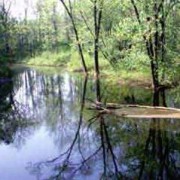
Today, Putnam County has managed to strike a balance between change and preservation and between development and conservation. It will be the challenge of the 21st century to continue on that difficult path.
Town & Village Links
Archival and documentary sources in the county are often to be found in its towns and villages. Vital records (births, marriages and deaths) have been kept in the offices of the town and village clerks who are the records management officers (RMOs) of their municipalities.
Each local government has a local government historian who may be contacted if you have questions about his or her town or village.
If you are interested in a particular town or village, click on the municipality to learn about the RMOs, the municipal historians, the local historical societies and museums, and the local libraries.
Village of Nelsonville
VILLAGE HISTORIAN:
Michael Bowman
244 Main Street
Cold Spring NY 10516
RECORDS MANAGEMENT OFFICER:
Village Clerk: Mlissa Harris
258 Main Street, Cold Spring NY 10516
(845) 265-2500 FAX (845) 265-2351
E-mail:
Web site: http://www.villageofnelsonville.org
PUTNAM HISTORY MUSEUM
63 Chestnut Street, Cold Spring NY 10516.
(845) 265-4010
FAX: (845)265-2884
E-mail:
Web site: www.putnamhistorymuseum.org
Executive Director: Cassie Ward
BUTTERFIELD MEMORIAL LIBRARY;
10 Morris Ave., Cold Spring NY 10516.
Tel: (845) 265-3040. FAX: (845) 265-4852.
E-mail :
Website : www.butterfieldlibrary.org
Town of Philipstown
TOWN HISTORIAN:
Mark Forlow
21 Lake Surprise Road, Cold Spring NY 10516
(914) 548-8411
E-mail: mjmforlowoptonline.net
RECORDS MANAGEMENT OFFICER:
Town Clerk Tara K. Percacciolo
Townhall
238 Mainstreet
Cold Spring NY 10516
(845) 265-3329; FAX: (845) 265-3958
E-mail:
PUTNAM HISTORY MUSEUM
63 Chestnut Street, Cold Spring NY 10516.
(845) 265-4010 FAX: (845)265-2884
E-mail:
web site: www.putnamhistorymuseum.org
Executive Director: Cassie Ward
BUTTERFIELD MEMORIAL LIBRARY:
10 Morris Ave., Cold Spring NY 10516.
Tel: (845) 265-3040. FAX: (845) 265-4852.
E-mail :
Website : www.butterfieldlibrary.org.
ALICE DESMOND & HAMILTON FISH LIBRARY:
472 Route 403, PO Box 266, Garrison NY 10524.
Tel: (845) 434-3020. FAX : (845) 424-4061.
E-mail:
Website: www.desmondfishlibrary.org
Town of Carmel
TOWN HISTORIAN:
Alicia Briley
Carmel Town Hall
60 McAlpin Ave
Mahopac NY 10541
(845)628-1500
Fax (845)628-7434
Email:
RECORDS MANAGEMENT OFFICER:
Town Clerk: Alice Daly
60 McAlpin Avenue, Mahopac NY 10541
Tel: (845) 628-1500 FAX (845) 628-7434
Email:
TOWN OF CARMEL HISTORICAL SOCIETY:
P.O. Box 456, Mahopac NY 10541-0808
Tel. (845) 628-0500.
President: Alicia Briley
Email:
MAHOPAC PUBLIC LIBRARY:
668 Route 6, Mahopac NY 10541.
Tel: (845) 628-2009. FAX: (845) 628-0672. E-mail:
Website: www.mahopaclibrary.org.
REED MEMORIAL LIBRARY:
1733 Route 6, Carmel NY 10512.
Tel: (845) 225-2439. FAX: (845) 225-1634.
E-mail:
Website: Reed Library
Village of Cold Spring
VILLAGE HISTORIAN:
Mark Forlow
21 Surprise Lake Rd, Cold Spring NY 10516
(914) 548-8411
E-mail:
RECORDS MANAGEMENT OFFICER:
Village Clerk: Jeff Vidakovich
87 Main Street
Cold Spring NY 10516
(845) 265-3611 FAX: (845) 265-1002
E-mail:
PUTNAM HISTORY MUSEUM:
63 Chestnut Street, Cold Spring NY 10516.
(845) 265-4010 FAX: (845)265-2884
E-mail:
Web site: www.PutnamHistoryMuseum.org
Executive Director: Cassie Ward
BUTTERFIELD MEMORIAL LIBRARY:
10 Morris Ave., Cold Spring NY 10516
Tel: (845) 265-3040. FAX: (845) 265-4852.
E-mail :
Website : www.butterfieldlibrary.org
Village of Brewster
RECORDS MANAGEMENT OFFICER:
Village Clerk Michelle Diebold
208 East Main Street, Brewster NY 10509
(845) 279-3760
E-mail:
SOUTHEAST MUSEUM,
67 Main Street, Brewster NY 10509
(845) 279-7500 FAX (845)279-1992
E-mail:
Web site: http://www.southeastmuseum.org
Executive Director:
BREWSTER PUBLIC LIBRARY,
79 Main Street, Brewster NY 10509.
Tel: (845) 279-6421. FAX: (845) 279-0043
E-mail:
Website: www.brewsterlibrary.org
Town of Kent
TOWN HISTORIAN:
J. S. Rohrig
25 Sybil’s Crossing, Kent Lakes NY 10512.
Tel: (845) 306-5589
Email:
RECORDS MANAGEMENT OFFICER:
Town Clerk: Yolanda D. Cappelli
Kent Town Hall
25 Sybil’s Crossing, Kent Lakes NY 10512
Tel.: (845) 225-2067 FAX: (845) 225-5130
E-mail:
KENT HISTORICAL SOCIETY:
President: Cark Darling
PO Box 123 Carmel, New York 10512
Tel: (845) 225-8366
Email:
KENT PUBLIC LIBRARY:
17 Sybil’s Crossing, Kent Lakes NY 10512. Tel: (845) 225-8585. FAX: (845) 225-8549
E-mail :
Website : www.kentlibrary.org.
Patterson
TOWN HISTORIAN:
Dr. Larry A. Maxwell
595 Route 311, Patterson NY 12563
Tel.: (845) 878-4160
E-mail:
RECORDS MANAGEMENT OFFICER:
Town Clerk: Donna Ramos
1142 Route 311, P.O. Box 470
Patterson NY 12563
(845) 878-6500 FAX (845) 878-6343
E:mail:
PATTERSON HISTORICAL SOCIETY:
P.O. Box 534, Patterson, NY 12563.
www.pattersonhistoricalsociety.org
President: Ron Taylor
E-mail:
Website: www.pattersonhistoricalsociety.org
PATTERSON PUBLIC LIBRARY:
P.O. Box 418, 1167 Route 311
Patterson NY 12563.
Tel : (845) 878-6121. FAX : (845) 878-3116.
Website : www.pattersonlibrary.org
Town of Putnam Valley
TOWN HISTORIAN:
Daniel T. Ricci
265 Oscawana Lake Road, Putnam Valley NY 10579 Tel: (845) 526-2121
E-mail:
RECORDS MANAGEMENT OFFICER:
Kathy Diomede, Interm Town Clerk
265 Oscawana Lake Road
Putnam Valley NY 10579
Tel.: (845) 526-3280 FAX: (845) 526-2130
E-mail:
PUTNAM VALLEY HISTORICAL SOCIETY:
301 Peekskill Hollow Road, P.O. Box 297, Putnam Valley NY 10579
Tel: (845) 528-1024
Executive Director: Gretchen Weiglein
E-mail:
PUTNAM VALLEY FREE LIBRARY:
P.O. Box 425, 30 Oscawana Lake Road, Putnam Valley NY 10579
Tel: (845) 528-3242 ; FAX: (845) 528-3297
Email:
Website : www.putnamvalleylibrary.org.
Town of Southeast
TOWN HISTORIAN:
John Alcot
Town of Souteast
1360 Route 22
Brewster NY 10509
or
RECORDS MANAGEMENT OFFICER:
Town Clerk Kathleen Chiudina
P.O. Box O. Brewster NY 10509
(845) 279-2196 FAX (945) 279-4399
E-mail:
SOUTHEAST MUSEUM
67 Main Street, Brewster NY 10509
(845) 279-7500 FAX (845)279-1992
E-mail:
Web site: http://www.southeastmuseum.org
Executive Director:
BREWSTER PUBLIC LIBRARY
79 Main Street, Brewster NY 10509.
Tel: (845) 279-6421. FAX: (845) 279-0043
E-mail:
Website : www.brewsterlibrary.org.
